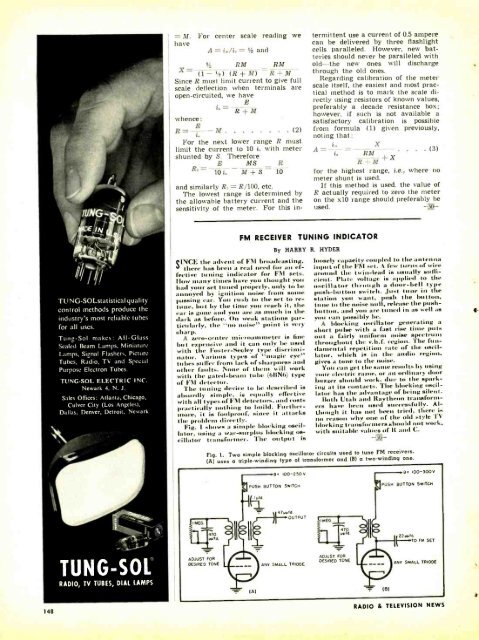T EVIS i - AmericanRadioHistory.Com
T EVIS i - AmericanRadioHistory.Com
T EVIS i - AmericanRadioHistory.Com
You also want an ePaper? Increase the reach of your titles
YUMPU automatically turns print PDFs into web optimized ePapers that Google loves.
= M. For center scale reading we<br />
have<br />
A= i. /i, =t /z and<br />
RM<br />
RM<br />
X (1 -t) (R +M) R + M<br />
Since R must limit current to give full<br />
scale deflection when terminals are<br />
open- circuited, we have<br />
E<br />
i, _ R+M<br />
whence:<br />
R= E -M (2)<br />
i.<br />
For the next lower range R must<br />
limit the current to 10 i. with meter<br />
shunted by S. Therefore<br />
E MS R<br />
10 i M + S 10<br />
and similarly R, = R /100, etc.<br />
The lowest range is determined by<br />
the allowable battery current and the<br />
sensitivity of the meter. For this in-<br />
termittent use a current of 0.5 ampere<br />
can be delivered by three flashlight<br />
cells paralleled. However, new batteries<br />
should never be paralleled with<br />
old -the new ones will discharge<br />
through the old ones.<br />
Regarding calibration of the meter<br />
scale itself, the easiest and most practical<br />
method is to mark the scale directly<br />
using resistors of known values,<br />
preferably a decade resistance box;<br />
however, if such is not available a<br />
satisfactory calibration is possible<br />
from formula (1) given previously,<br />
noting that:<br />
A = do<br />
= RMX . . . (3)<br />
R +M +X<br />
for the highest range, i.e., where no<br />
meter shunt is used.<br />
If this method is used, the value of<br />
R actually required to zero the meter<br />
on the x10 range should preferably be<br />
used.<br />
-S-<br />
TUNG- SOLstatistical quality<br />
control methods produce the<br />
industry's most reliable tubes<br />
for all uses.<br />
Tung -Sol makcs: All -Glass<br />
Scaled Beam Lamps. Miniature<br />
Lamps, Signal Flashers, Picture<br />
Tubes. Radio, TV and Special<br />
Purpose Electron Tubes.<br />
TUNG -SOL ELECTRIC INC.<br />
Newark 4, N. 3.<br />
Sales Offices: Atlanta, Chicago,<br />
Culver City (Los Angeles),<br />
Dallas, Denver, Detroit, Newark<br />
FM RECEIVER TUNING INDICATOR<br />
By HARRY R. HYDER<br />
the advent of FM broadcasting.<br />
SINCE there has been a real need for an effective<br />
tuning indicator for FM sets.<br />
How many times have you thought you<br />
had your set tuned properly, only to be<br />
annoyed by ignition noise from some<br />
passing ear. You rush to the set to retune.<br />
but by the time you reach it. the<br />
car is gone and you are as nu ch in the<br />
dark as before. On weak stat' s particularly.<br />
the "no noise" point is very<br />
sharp.<br />
A zero -center microammeter is fine<br />
but extensive and it can only be used<br />
with the Foster -Seeley type discriminator.<br />
various types of `magic eye"<br />
tutus suffer fr lack of sharpness and<br />
other faults. N of them will work<br />
with the gated -beum tube (6ßN6) type<br />
of FBI detector.<br />
The toting device to be described is<br />
absurdly simple. is equally effective<br />
with all types of FM detectors. and costs<br />
practically nothing to build. Furthermore,<br />
it is foolproof. since it attacks<br />
the problem directly.<br />
Fig. 1 shows a simple blocking oscillator,<br />
using a war- surplus blocking oscillator<br />
transformer. The output is<br />
loosely capacity coupled to the antenna<br />
input of the FM set. A few turns of wire<br />
around the twin -lead is usually sufficient.<br />
Plate voltage is applied to the<br />
oscillator through a door -bell type<br />
push -button switch. Just tune in the<br />
station you want. push the button,<br />
tune to the noise null, release the pushbutton,<br />
and you are tuned in as well as<br />
you can possibly be.<br />
A blocking oscillator generating a<br />
short pulse with a fast rise time puts<br />
out a fairly uniform noise spectrum<br />
throng' t the v.h.f. reg. . The fundamental<br />
repetition rate of the oscillator,<br />
which is in the audio region,<br />
gives a tone to the noise.<br />
You can get the same results by using<br />
your electric razor, or an ordinary door<br />
buzzer should work, due to the sparking<br />
at its contacts. The blocking oscillator<br />
has the advantage of being silent.<br />
Both Utah and Raytheon transformers<br />
have been used successfully. Although<br />
it has not been tried. there is<br />
no reason why one of the old style TV<br />
blocking transformers should not work,<br />
with suitable values of It and C.<br />
Fig. 1. Two simple blocking oscillator circuits used to tune FM receivers.<br />
(A) uses a triple-winding type of transformer and (B) a two -winding one.<br />
B. 100 -250v<br />
B<br />
IDO-300V<br />
-<br />
PUSH BUTTON SWITCH<br />
PUSH BUTTON SWITCH<br />
lyld<br />
MEG<br />
470<br />
pet<br />
OUTPUT<br />
MEG<br />
ÿ7O<br />
ud<br />
4.<br />
II<br />
e22yy1d.<br />
TO FM SET<br />
TUNG -SOL<br />
RADIO, TV TUBES, DIAL LAMPS<br />
ADJUST OR<br />
DESIRED TONE<br />
A)<br />
ANY SMALL TRIODE<br />
ADJUST FOR<br />
DESIRED TONE<br />
BI<br />
ANT SMALL TRIODE<br />
i<br />
148<br />
RADIO &<br />
TEL<strong>EVIS</strong>ION NEWS

















